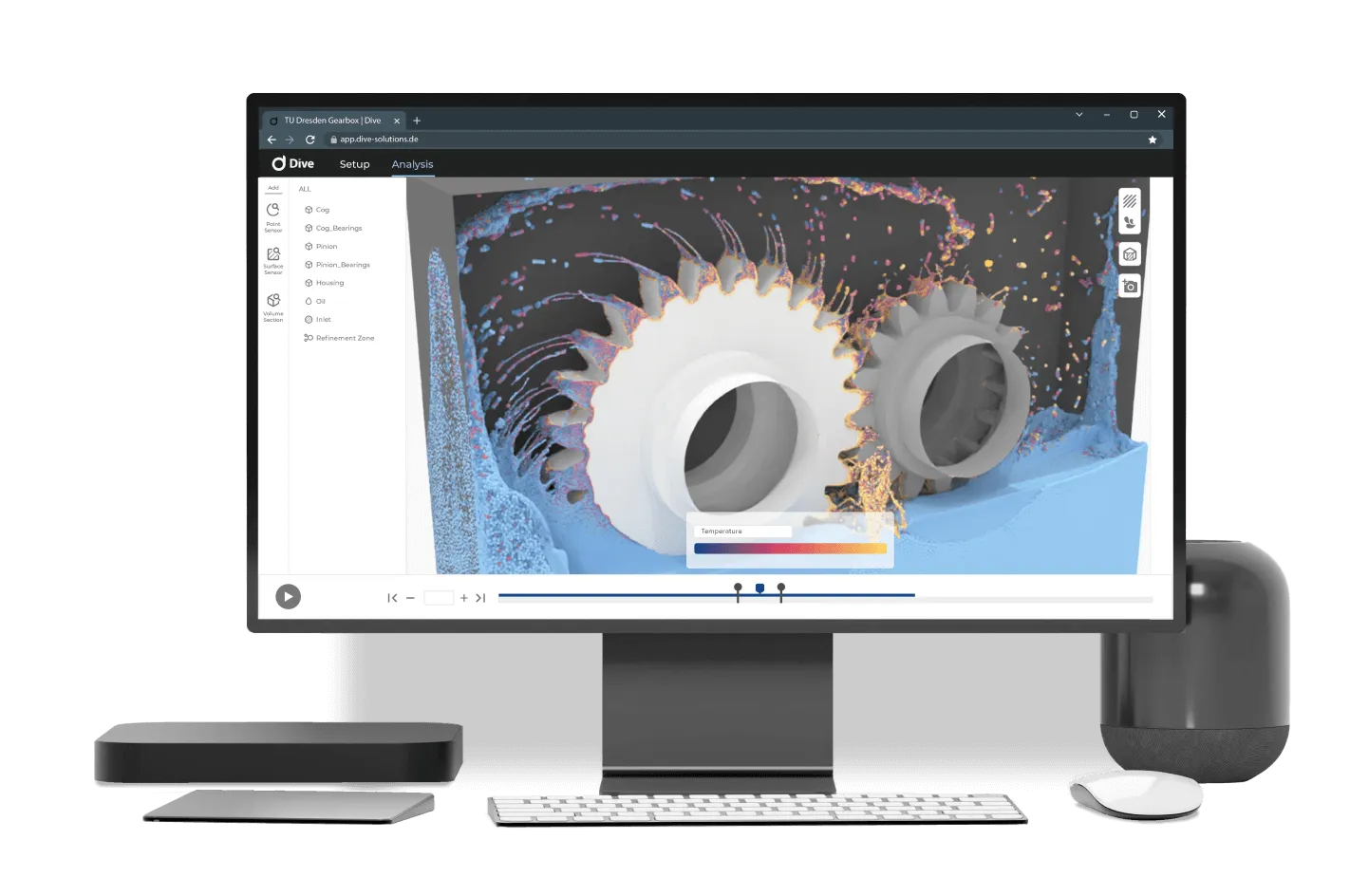
Improved cycle time: Simulation helps to identify best results in less time, prevent failure in automated cleaning processes and shorten process times leading to reduced energy and water consumption.

Analyze mechanical cleaning forces: Simulation allows to to optimize residue removal forces, leading to a more precise washing process.

Chemical cleaning: Virtual testing can ensure a better mixing of fluids, including washing detergents.

Calculate temperature: A detailed analysis of temperature distribution can save energy and costs.

The Sinner's Circle is an important concept in chemical cleaning technology and describes the interaction of four factors that play a role in cleaning. These factors are: Time, mechanical force, chemistry and temperature. This concept is particularly useful for determining the optimal conditions for cleaning various surfaces and materials and ensuring that cleaning processes are efficient and effective. It helps in selecting the right cleaning process to achieve optimal results. With SPH simulation, all of those factors can be analyzed and optimized.
Engineers in the household appliance industry are optimizing the cleaning result in dishwashers by testing different spray arms and water pressures. They are analyzing the water distribution to ensure that all dishes are cleaned adequately. By optimizing fluid impact forces and water velocities soil is removed from the dishes. One of the major goals of manufacturers is to ensure that the dishwashers thoroughly clean their contents while being as energy efficient as possible. With simulation engineers can virtually test different designs, loads, and operating points to optimize both the cleaning process as well as the energy and water consumption for the best possible outcome, before going into production.
The same applies to large industrial dishwashers and automated cleaning lines in the food and pharmaceutical industries, such as GMP washers for cleaning and sterilization of pharmaceutical and laboratory equipment. These systems are often customized and can handle different sizes of equipment up to very large tanks.

Cleaning in the Processing Industry:
In the chemical and construction industries, engineers are designing large tanks with cleaning nozzles. To optimize the amounts and locations of the nozzles, engineers analyze the water distribution and wall shear stresses resulting from the water jets. With an SPH software, it’s possible to virtually test the cleaning results and identify the best performing design without the need to build physical prototypes.
Tanks in liquid processing that contained e.g. chemicals, food, beverages or concrete, must be properly cleaned to ensure product purity, safety, and compliance with industry regulations and standards. However, this cleaning process can be resource-intensive, particularly in terms of water and energy consumption.
In the following example, twin nozzles within a tank initiate rotation through the force generated by the water. Both the rotatory motion of the nozzle and the cleaning of the tank are a result of forces exerted by the water. A good cleaning result requires certain shear and normal forces to eliminate residues. It's important to note that excessive forces do not necessarily lead to better cleaning results. The optimal force, and consequently, the ideal water volume, must be precisely calibrated to remove residues efficiently. A fluid dynamics simulation can help with this, as it allows to compute the forces exerted from the fluid to the wall. This is visualized in the video below:
Cleaning in Manufacturing:
Every manufacturing process includes parts cleaning. In automated manufacturing lines, robot arms move parts as they are cleaned by a high-pressure water jet. By optimizing this cleaning process already during the design phase of the production line, significant time and energy can be saved.
Measuring the fluid flow and resulting forces with experiments is very difficult or not even possible. In the past, it was only possible to test the cleaning result with a special liquid representing the soil, and then analyze the result visually after the process. It was not possible to see anything during the process and placing measurement instruments was very limited. With today’s simulation technology, it is possible to calculate pressures, velocities, and forces on every spot in the system during the entire process, as the video below demonstrates. By understanding the influence of different parameters during the process, engineers can create superior products in less time and easily analyze different points of interest.
To effectively eliminate contaminants such as metal chips, oil, and other residues from the manufacturing process, it is crucial to guarantee sufficient forces within drillings and cavities. Simulation enables precise measurement of the required parameters at every location:

Surface tension without artificial tuning parameters to calculate effects like capillary effects in gaps and droplet formation

Complex moving and stationary components to simulate geometrically complex parts including windings

Heat transfer to improve cooling concepts, e.g. modern direct oil cooling concepts
If your engineering team is dealing with liquids and heat management, chances are this is the right software for you.
Use the Dive CFD software, free for a week, including service by a Customer Success Engineer who will ensure successful results for your project. No strings attached. Comfortably evaluate your project before you commit to a subscription.


A Dive representative will contact you, typically within 1 business day. Note: Only registrants with valid use cases will be contacted.